2025 Guide: Pricing Your Apple Store App Launch
Rahul Motwani
January 02, 2025 221 Views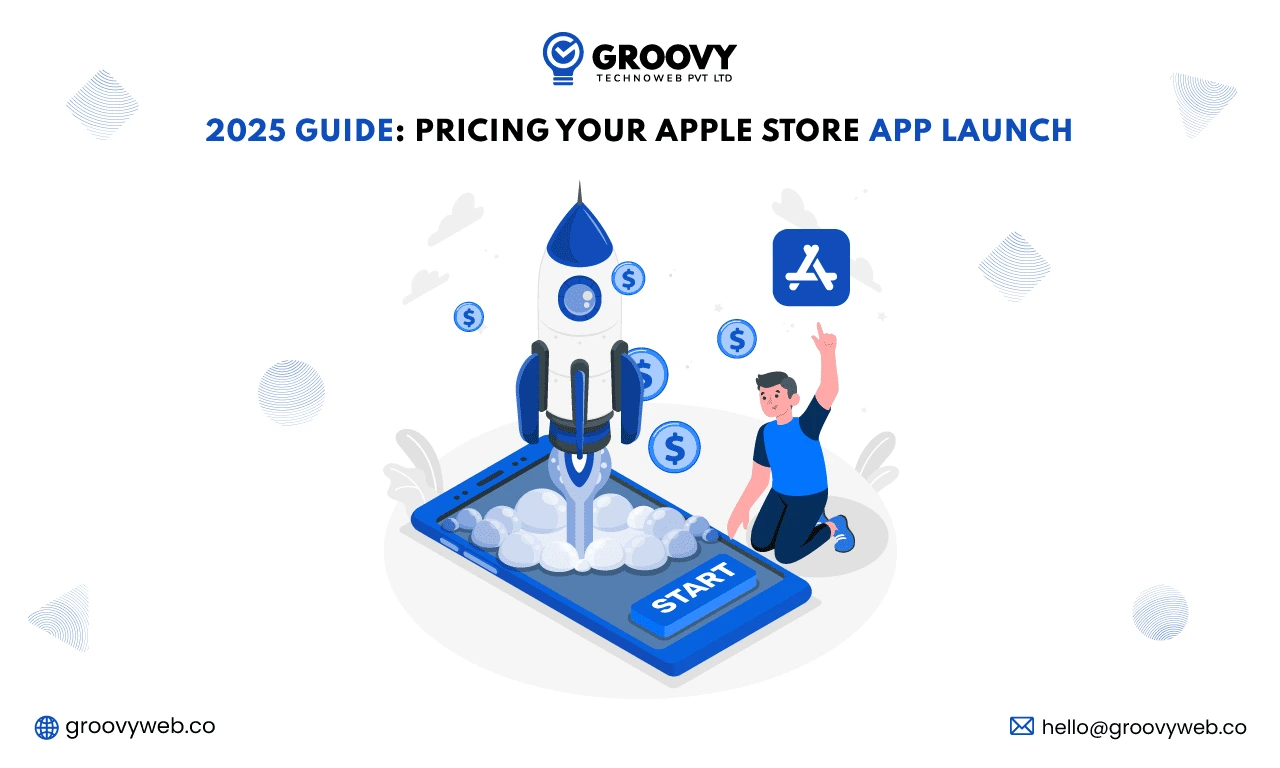
Quick Summary : App store optimization means that there are various costs that should be considered before launching an app on the Apple App Store; the level of app’s complexity, the issue of platform optimization, the developer’s location, and the issue of design. The cost of development of an application ranges between $10000 and $250000 depending on the features and functionalities of the app. Other expenses are the annual Apple Developer Program fee of $99, the cost of marketing, and the maintenance cost. To work with budgets, it is possible to utilize certain methods, including the creation of an MVP, cross-platform frameworks, and outsourcing to efficient areas. For revenue generation, one can consider using the concept of freemium, in-app purchases, and advertisement that assist in managing the costs effectively.
Apple App Store is recognized as a marketplace for mobile applications, with millions of apps developed using proper iOS application development for various industries and customers’ expectations. In turn, the App Store enjoys remarkable sales revenues, especially for businesses and developers, owing to the increasing use of iOS devices across the global populace. Business people and other entities aim to capitalize on the expanding iOS market on iPhones, iPads, and even watches, as Apple Store apps are popular in 2025.
This is why developers and entrepreneurs need to know the cost of developing apps. Proper pricing in cases of the apps helps in making profits and survival of the applications in the market despite the intense competition. But it does not end with development; constant updates, management, and the right approach to monetization are vital to its sustainability.
To successfully bring an application to the Apple App Store, is not just a question of writing lines of code. It is about identifying what app features and UX are required in the market and how to create a sustainable model of monetization of the demand. Hence, this guide will provide an understanding of the most critical costs, budgeting, and revenue generation strategies including the question of how much it costs to publish an app on the Apple Store.
The Importance of Pricing Your Apple Store App Correctly
When deciding the price range for an app, you should consider its positioning, downloads, and revenue potential. In the Apple App Store where there are over 2 million apps, mispricing will result in low downloads, low user satisfaction, and lost sales. Pricing is a crucial aspect, especially when determining the cost to publish the iOS app and other related costs. Here’s why it matters:
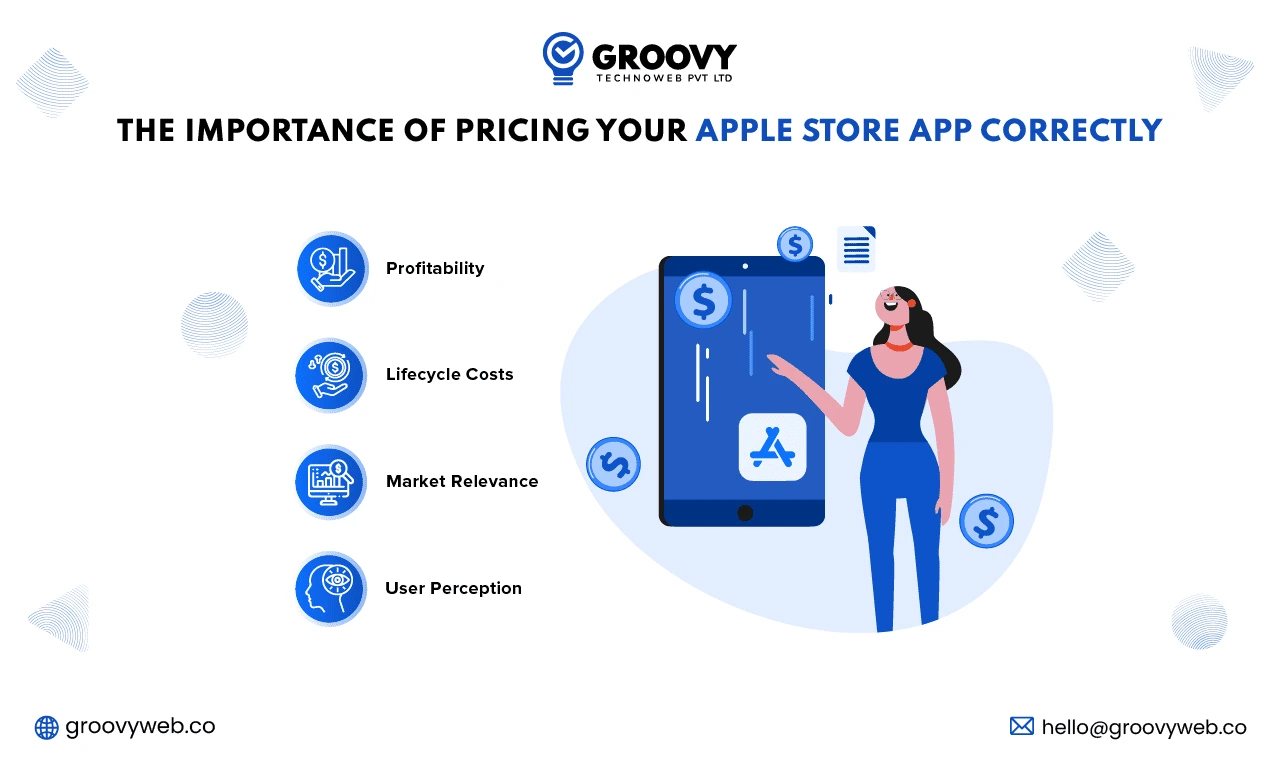
1. Profitability
As per Apple, managing pricing is a factor that determines the actual worth of your app and its ability to stand a competitive market share. As pointed out earlier, revenue to support further app development and to achieve a sustainable income flow requires the use of an appropriate pricing model. This entails the cost to publish an iOS app and the operational cost that involves app maintenance and promotions. Costs also must be low, and at the same time, it should be possible to earn money on it, thus making users choose your application.
2. Lifecycle Costs
Although the cost to publish an iOS app is considerable, launching and maintaining the app requires additional expenses. App development involves continuous updates, new features, customer service, and maintenance for the app to remain popular. These are the types of expenses that you have to include in your pricing model since they keep recurring. This may prove difficult to cover the above costs, whereas appropriate pricing leads to attainable and sustainable income.
3. Market Relevance
Due to the increased number of applications and with more than a million applications in the Apple App Store, one cannot be charged for an application. It also involves values by checking the effectiveness of a system against the value of developing it. A high price may force the users to shift to another product while on the other hand, a low price may cause users to develop a negative perception about the product. This can also be seen from factors like how much it costs to publish an app or Apple store app where the fine line between customer requisite and cost leads to credibility and success.
4. User Perception
Pricing is important because consumers place different values on your application. A premium price can signal quality but should match the product, while free or low-price apps may gain downloads but seldom have efficient monetization strategies like IAPs and subscriptions. When it comes to app publishing on the Play Store or the Apple App Store, one must consider the cost of an app on App Store pricing and its relation to monetization strategies.
Factors That Affect the Cost of Developing Apps
To help formulate an effective budget, it is vital to understand mobile app development costs. The cost and the success of a project depend on the complexity of the application, the location of a developer, and the requirements of the platform. On the same note, understanding how to monetize an app guarantees that there will be revenues generated to support the costs incurred to build a mobile app. Let’s explore these factors further:
2.1 App Type and Complexity
The scale of your vision and the features you want in your intended app are also among the factors that determine the total cost of developing an app. Here’s a closer look at the variations:
- Simple Apps: Components such as calculators or to-do list applications that do not require much design and back end which makes their development cheap. Development costs are between $10,000 and $30,000. Another cost that should be taken into consideration is the cost to publish the iOS app including the Apple Developer Account fee and other other costs incurred in the process.
- Medium Complexity Apps: Depending on the nature of the app such as the fitness tracking apps, and e-commerce apps which would require API integration, custom UX/UI, and databases among others, the cost of these apps falls between $40,000 and $100,000. They also would like to know how much it costs to publish an app on the app store, the annual fee, and any other charges that a business may incur at the point of launching an app.
- Complex Apps: These apps do provide real-time updates and can have AI parts and secure backends; costs differ, but some might go over $100,000. From apps, such as Uber or Airbnb, there must also exist a plan on how to monetize an app, either through paywalls or through subscriptions to be able to recuperate the costs and make money back.
2.2 Platform Optimization
It is essential to note that developing an application specifically for the iOS environment has its challenges and contributes to the cost of application development faced by iOS developers. Two key factors are:
- Device Compatibility: Apple’s ecosystem consists of various tools including iPhones, iPads, and Apple Watches among others. These all require integration among themselves, and this means additional coding and beta testing work, especially in the context of iOS mobile app development.
- Compliance with Apple Standards: Apple has strict regulations that it follows when it comes to the apps that are submitted to the Apple App Store. Non-adherence to these measures leads to rejection of the product and this means that a lot of time and valuable resources have been used in vain. During this phase, they are easily approved because of adherence to these guidelines hence saving on costs.
2.3 Developer Location
The geographical location of your development team significantly impacts costs, as developer rates vary widely across regions:
- North America: These can cost anywhere from $100 to $200 per hour and this reflects the quality and experience that is often present in the individuals here referred to as developers.
- Europe: Regardless of the price of the service which can cost between $50 and $100 per hour, Europe can be viewed as an inexpensive yet qualitative service provider.
- Asia: Asian developers charge $20 to $50 per hour, yet they remain among the most preferred outsourcing options and don’t compromise the quality of work.
2.4 Features and Functionalities
The features that you intend to incorporate in your app are critical in influencing the cost of the app. Nevertheless, the mobile app development cost is much lower when outsourced to less valued markets, as long as there is good talent.
Advanced functionalities add value but also increase complexity:
databases, customization, design, and app programming interfaces (APIs) for applications like e-commerce or productivity. In-App Purchases: These have to be integrated with a secured payment gateway and are important in-app monetization in freemium or subscription-based apps.
- Push Notifications: There is also the importance of back-end systems in the case of traditional media as audience updates and interaction require robust systems.
- Security Features: Features like end-to-end encryption are important in apps that handle sensitive information for a user and incur cost implications.
2.5 Design and User Experience (UX)
The significance of such an experience cannot be overemphasized since it contributes to the download, usage, and loyalty of the application. Two critical aspects of UX design are:
- Custom Designs: Customizations make it possible to acquire a unique appearance and style for an app that will distinguish it from other similar apps. However, they require more time and expertise relative to the creation of templates and are therefore expensive.
- Usability Testing: This minimizes the occurrence of crashes and enhances user interest by ensuring the app runs smoothly on numerous devices. It is more important in the case of Apple App Store submissions as applications that perform poorly might be rejected.
Why These Factors Matter
It is also important to understand that any aspect tied to the development of apps counts towards the cost of developing apps. When you understand these factors, it becomes easier to rank features based on your objectives and avoid making costly mistakes. No matter if you are developing a basic tool application or an application with various features, planning all these components will help to reach the goal – creating an application with use for users and within the given time frame and financial constraints.
Mobile App Development Cost Breakdown
In the context of a mobile app, it is crucial to know about cost ranges and avoid setting expectations too high. The cost of creating an app depends on the complexity and functionality of the app and the technology it uses in the project. Whether targeting the Apple App Store or planning an app publication on Play Store, here’s a breakdown to understand the financial commitment for various app types:
1. Basic Apps: $10,000–$30,000
Utility apps are suitable for having bare minimums such as calculators or simple activity trackers intended for use in a specific way. Since they do not require intricate backends and links to other systems, they are affordable for startups and businesses experimenting with ideas. The cost of developing apps is quite inexpensive, which makes them ideal when you are short on resources or if it is your first time coming up with an application.
Key Features of Basic Apps:
- Simple user interface (UI).
- Functionalities like data entry, display, or calculations.
- Minimal or no interactions with the server side of a page.
Best For:
- Small businesses seek a fast and effortless way of creating an online presence.
- Individuals who are experimenting with a concept before going large-scale.
2. Medium Complexity Apps: $40,000–$100,000
Features that fall under medium complexity include it is crucial to familiarize how to monetize an app, be it through subscription or in-app purchases to offset the costs of developing them.
Key Features of Medium Complexity Apps:
- Custom UX/UI designs to ensure the company has unique brand designs.
- Compatible with other services like payment integrations or social media account access.
- Database connection for storing and managing user information.
- Improved security measures to protect information.
Best For:
- Businesses that require more captivating and effective app solutions for their users.
- Enterprises focusing on direct client engagement, like the technology or the service-based industries.
3. Advanced Apps: $100,000–$250,000 or More
Enterprise solutions are high-end applications designed for enterprises that include real-time analytics, artificial intelligence backends, and updates. However, the cost of developing an iOS app involves other costs that need to be met for a successful Apple App Store launch, such as the cost of publishing an iOS app, which entails the annual Apple Developer Account fee.
Key Features of Advanced Apps:
- Functions as recommendation systems or other AI-based tools and services.
- Real-time features like tracking in real-time, having a real-time chat window or streaming.
- Reliable back-end solutions to support many users and sophisticated processes.
- Features like End-to-End Encrypted messages and messages will be strictly GDPR compliant.
Examples:
- Ride-sharing apps such as Uber, Lyft, etc.
- Online streaming services such as Netflix or Spotify.
- Consumer apps for social networking, booking accommodations, streaming music, or shopping.
Best For:
- Enterprises that require complex applications for their processes or services provided to their clients.
- Companies that wish to bring new innovative solutions regarding digitalization in their markets.
Budgeting for Additional Expenses
Developing an app is only half the battle – launching and sustaining it comes with further expenses. When considering an app to be published in the Apple App Store or an app published on the Play Store, the following costs should be factored.
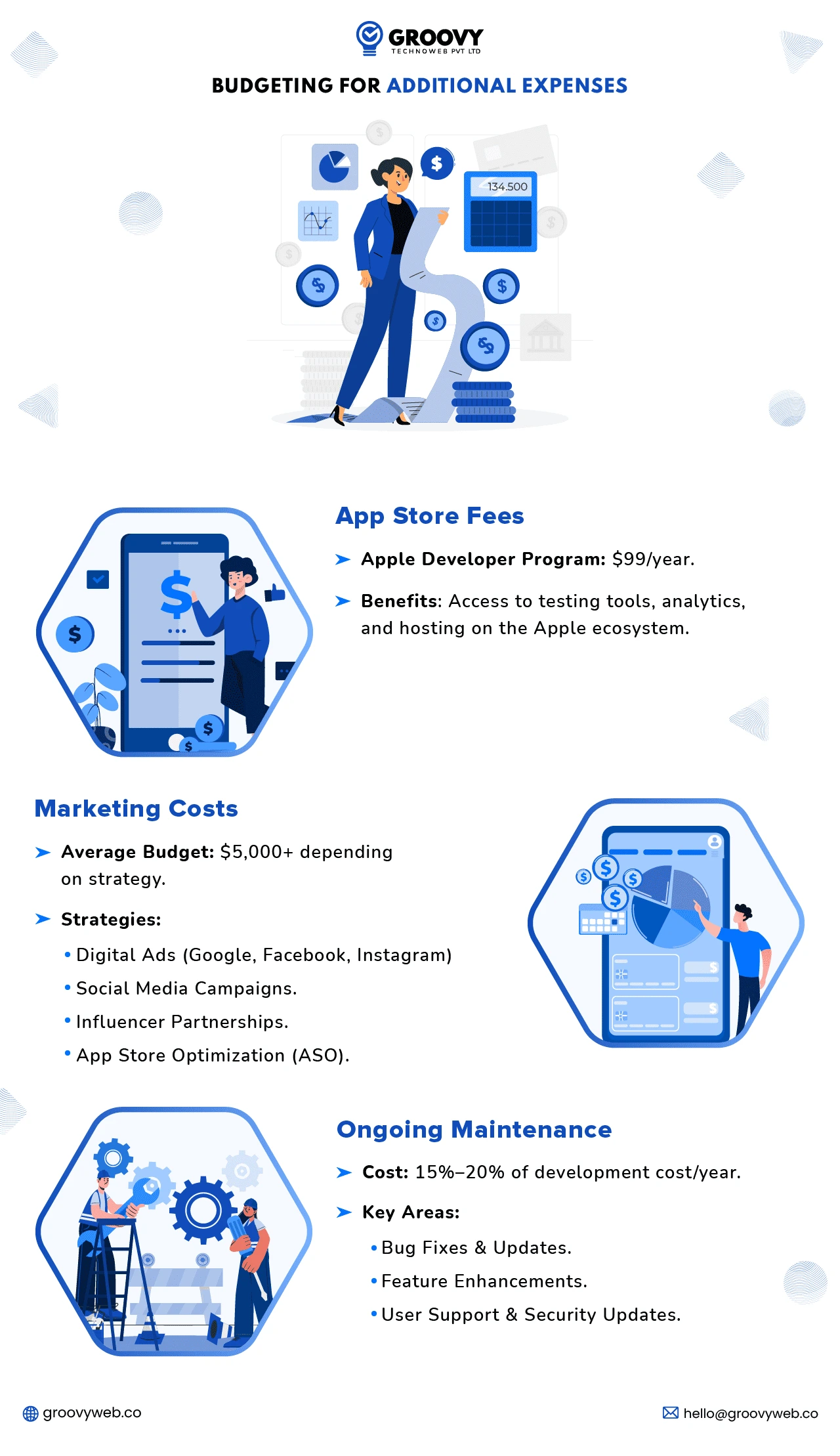
1. App Store Fees
To distribute your app on the Apple App Store, you need to enroll in an Apple Developer Program, which costs $99 per year. This fee gives you access to the developers’ interface, testing consoles, and the Apple ecosystem where your app is hosted.
Why It Matters:
- Make sure your application stays online for downloads as well as future updates.
- Offers an opportunity to open beta testing tools and analytics for tracking the outcome of the application.
2. Marketing Costs
After developing your app, the other major concern is to market it so that people will download and use it. Having a marketing plan in place is crucial for downloads and constant use of the application. Marketing costs depend on the applied techniques and the coverage level, typically ranging from $5,000 to more with expanded promotion.
Key Marketing Strategies:
- Digital Ads: Place ads on Google, Facebook Instagram, and others to ensure you target your desired group or demographic.
- Social Media Campaigns: Establish yourself on the platforms your target visitors go to to promote your presence or content.
- Influencer Partnerships: Partner with influencers to market your app and get credibility.
- App Store Optimization (ASO): Improve the visibility of your app by ensuring it is listed in the right category with appropriate keywords, appealing images, and concise descriptions.
Why It Matters: Often the actual applications may be good but if they are not marketed properly they cannot create a market for themselves easily. Ensuring your app gets discovered by your target audience requires adequate resource allocation to promote the app.
3. Ongoing Maintenance
Creating your app is easy; however, keeping the app running, evolving, and secure is a challenge. The estimated average maintenance cost of an app would be 15% – 20% of the total marketplace development cost every year and it is reliant on how complex your app is.
Key Components of Maintenance:
- Bug Fixes: Responding to the concerns of the users to help them have a smooth experience.
- Updates: Periodic releases to ensure that the app has compatibility with the latest iOS versions and devices.
- Feature Enhancements: Implementing new features according to users’ feedback to ensure sustained usage.
- User Support: Helping in addressing user issues and enhancing their level of satisfaction.
- Security Updates: Preserving user data and keeping this service away from potential violations of regulations like GDPR.
Why It Matters: If app owners fail to invest time and effort in sustaining their apps, they can end up providing users with subpar experiences, consequently leaving negative reviews as well as fewer downloads. Users spend more extended hours in the app, making it necessary to maintain consistency to ensure their loyalty is retained and even more customers are attracted to the app.
Cost-Saving Strategies for Developing Apple Store Apps
It is also important for the developer to know that it is possible to create a quality app without a large investment. The correct strategic approach and tools can lower expenses without struggling with usability or quality. These strategies make your app visible on the Apple App Store or during an app publication on the Play Store.
1. Launch a Minimum Viable Product (MVP)
- Focus on the core attributes and replicate the success based on these attributes by launching a product and receiving feedback on the marketplace. Eliminates the need for large initial investments and speeds up the process of getting to market.
2. Cross-Platform Development
- Develop applications for both platforms simultaneously using frameworks, such as Flutter or React Native to cut time and costs.
3. Outsource Smartly
- Outsourcing development is also a good tactic; there are many experienced developers in Asia or Eastern Europe. Select the teams that have a great track record to preserve quality for less expensive prices.
4. Leverage APIs and Pre-Built Solutions
- Use third-party services more often, such as for payment processing with Stripe or push notifications with Firebase since custom development work may not always be required.
5. Use Cloud-Based Services
- Choose more accessible and cost-effective services like AWS or Google Cloud instead of working with servers for backend processes.
6. Automate Testing
- Minimise manual quality assurance expenses by using programmatic frameworks such as TestFlight or Appium.
7. Reuse Design Elements
- Use templates or maybe open sources to minimize the costs of the UX/UI designers if they were created individually.
- When using these strategies, it is possible to create a quality application while at the same time, managing the budget.
Estimating Revenue to Offset Development Costs
Maximizing the monetization of your app is of great importance, especially in covering the cost to publish an iOS app as well as ensuring steady income is achieved. How to make money with the app is another crucial aspect to consider to guarantee that the application is financially viable in the long run. Here are some popular strategies:
- Freemium Models: Free versions of your app may contain limited functionality or some specific content, with paid options available for users to ‘unlock’ full or expanded features and features. It is quite suitable for applications that can easily scale, for instance, cloud storage or deep analytics.
- In-App Purchases: Give the option to the users to purchase the features, an upgrade, or content only available in the app. It is commonly used in gaming apps or productivity tools to make the checkout process easy and fast.
- Ad Revenue: Incorporate ads skillfully to tap on opportunities to monetize, yet continue offering free services for customers. Some of the ad formats possible with Google AdMob include banners, videos, or interstitials.
The knowledge of how to monetize an app makes provision for a feasible and functional business model in consonance with the user base.
Tools to Calculate Mobile App Development Cost
Mobile app development cost is an important process and using cost calculator tools can assist in this process. BuildFire, Outsystems, and other similar platforms offer guidelines on how costs might be determined depending on the type of application, feature requirements, and geographical location of the developers. They allow you to determine the overall financial potential of the project, for instance, how much it costs to publish an app on Apple Store and choose the best option among the types of development. To manage costs efficiently, it is possible to incorporate variables such as the platform, design, and functions into the formula. The use of these calculators is beneficial, making your app development planning process more transparent and informed.
Conclusion
Getting an app into the Apple App Store is not as simple as just building an app; it takes planning, definite pricing, and continued work in maintaining and marketing the app. Thus, by learning the mobile app development cost and applying such cost-optimization techniques as creating an MVP, using cross-platform frameworks, and outsourcing efficiently, you can control the costs and achieve high quality. One must consider outsourcing agencies that can help you in developing an Android app as well.
Monetizing your application through freemium models, in-app purchases, or advertisements can also allow you to ensure coverage of the costs and provide steady income. Also, the use of money for future necessities such as marketing, updates for the app, and the fees from the App Store can help to keep the app competitive and capture the interest of users.
Tools like BuildFire and Outsystems give good insight into the cost structure and assist you in cost budgeting. When your aims are well synchronized with market demands, when user experience is valued, and when scalability is considered, your app can offer great value and can be a true market winner from which a decent profit can be made. Ready to take the next step? The possibilities await!
Written by: Rahul Motwani
Rahul Motwani is an experienced Project Manager with a demonstrated history of working in the information technology and services industry. He started his career as a Backend developer and currently has his hands-on managing projects at Groovy Web. He is a strong program and project management professional with a Bachelor's degree focused on Computer Application.
Frequently Asked Questions
We hope these clear your doubts, but if you still have any questions, then feel free to write us on hello@groovyweb.coWhat are the characteristics that determine the cost of developing apps for the Apple App Store?
Some of these influential factors put into consideration include the level of complexity in the app, optimization on the platform, the features & functionalities in your app, the location of the developers, and the design of the app. These elements influence the time and resources required to develop the elements directly.
What is the average price that people spend to develop a mobile app?
The average price ranges:
- Basic apps: $10,000–$30,000
- Medium complexity apps: $40,000–$100,000
- Advanced apps: $100,000–$250,000 or more
How can we reduce the expenses in developing an Apple Store App?
You can save costs by:
- Launching a Minimum Viable Product
- Cross-platform frameworks such as Flutter
- Outsourcing services from different regions to make it cost-effective
- Taking advantage of APIs and pre-built solutions
What are the measures to monetize my Apple Store app?
Its monetization approach involves freemium with paid options, one-time in-app purchases, and ads that are integrated into the application. Both methods are beneficial in helping to balance out the development costs while maintaining high revenues.
Related Blog

Krunal Panchal
Groovy Web Recognized As A Top Web App Development Company
Achivements 14 Nov 2024 2 min read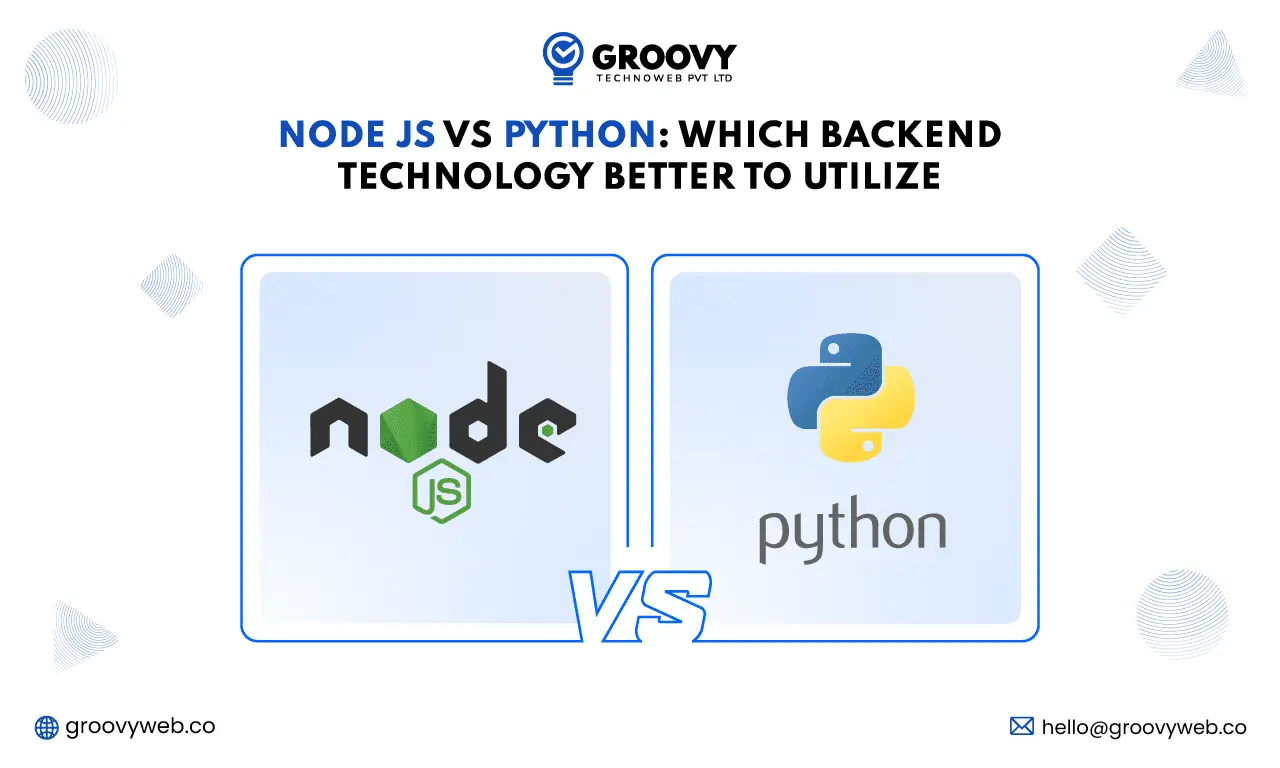
Rahul Motwani
Node JS vs Python: Which Backend Technology Better To Utilize
Web App Development 13 Nov 2024 8 min read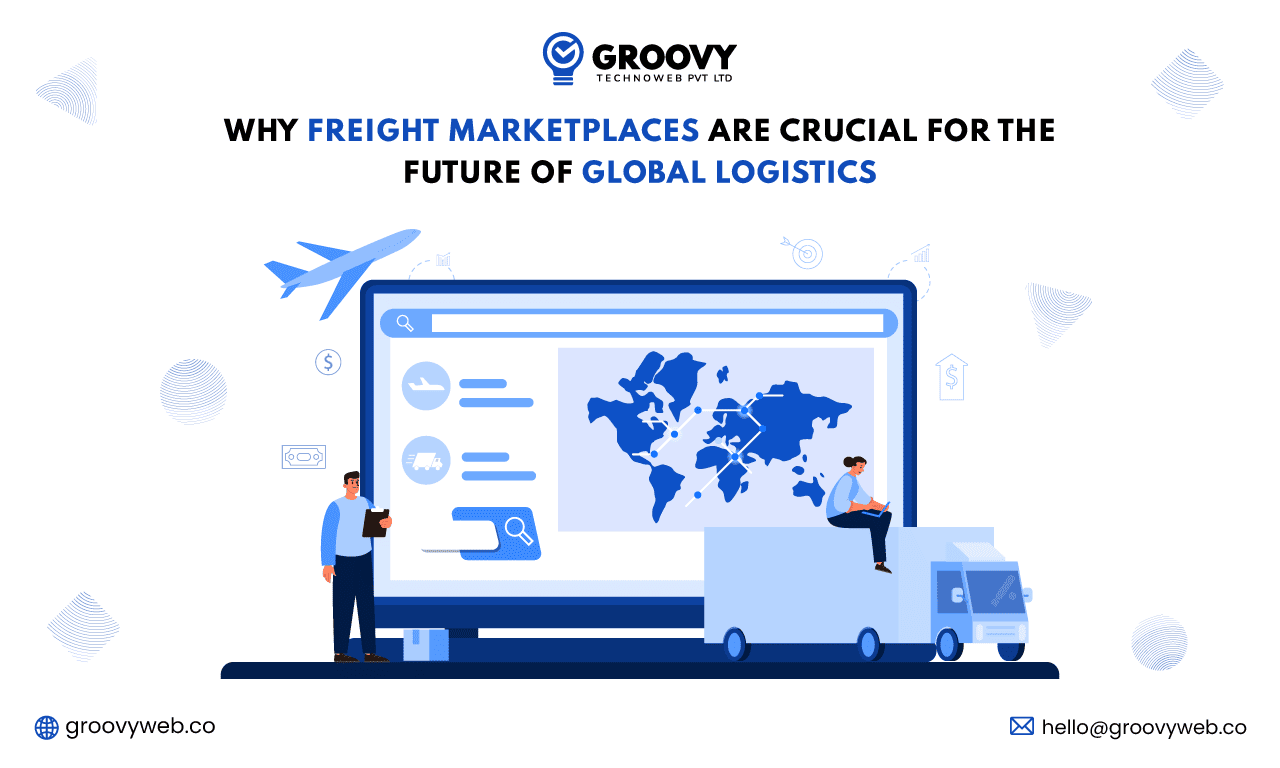
Rahul Motwani
Why Freight Marketplaces Are Crucial for the Future of Global Logistics
Mobile App Development 18 Dec 2024 10 min readSign up for the free Newsletter
For exclusive strategies not found on the blog